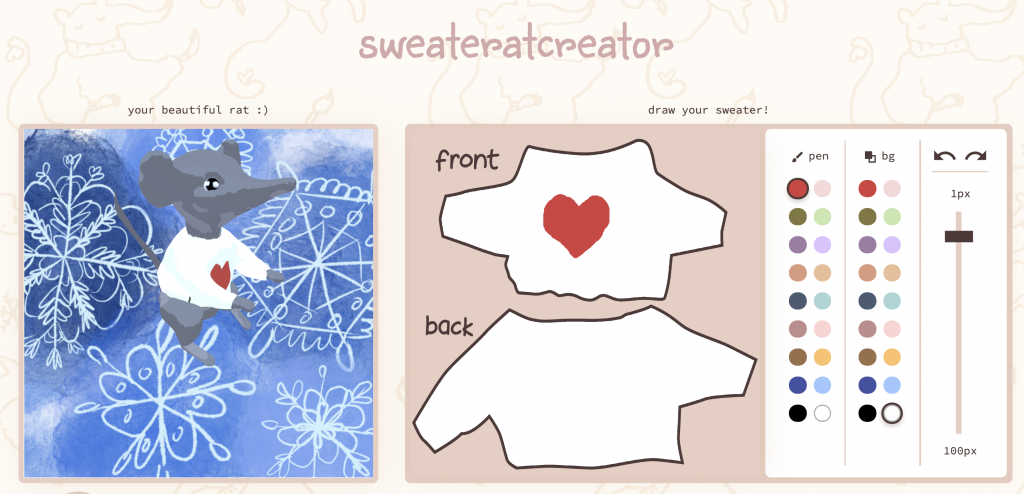Materials in this presentation are cribbed in part from:
- Weird-Drawing-Software, by Casey Reas
- Drawing Machines, lecture by Golan Levin (2020)
- Drawing Machines, lecture by Golan Levin (2016)
Paint Programs, A Quick History
Sketchpad (1963), Ivan Sutherland. First vector drawing program.
SuperPaint (1972), Richard Shoup et al. First frame buffer and raster drawing program.
- MacPaint (1984), Bill Atkinson
- Kid Pix (1989), Craig Hickman
Looom, by Finn Ericson and Eran Hilleli.
Open (Art)Works
Various strategies by artists for creatively augmenting the interactive experience of drawing.
- VideoPlace (1974-1989), Myron Krueger
- DynaDraw (1989), Paul Haeberli (p5.js)
- Re-move (1999-2003), by Lia
- Motion Phone (1995), Scott Snibbe (& Boopy Club)
- Yellowtail (1998), Golan Levin
- Bluetail (1998), Golan Levin
- Scribble Variations (2000), JT Nimoy
Zach Lieberman at Eyeo 2015 (watch from 7:20):
Land Lines (2017) Zach Lieberman
- Harmony, Mr. Doob
- Alchemy, Karl DD Willis. (“Shout at the computer. Use your voice to control the width of a line or the form of a shape…. Mirror draw. Draw mirrored symmetrical forms in realtime.”)
- Shrub (2014), Jeffrey Scudder
Doodal (2014), a fractal drawing tool by @:
AlgoRat Sweater Creator (2019), by Connie Ye, Tatyana Mustakos, Char Stiles, Caroline Hermans
A Sequence of Lines Traced by Five Hundred Individuals (2010) by Clement Valla
Experimental Tools
Rhonda Forever (2003), Amit Pitaru et al.
ShadowDraw (2011), Yong Jae Lee et al.
Magenta Magic Sketchpad
Magenta Sketch-RNN multi-predict drawing completion demo

Four Experiments in Handwriting with a Neural Network (2016), Shan Carter, David Ha, et al.
Teddy (1999), Takeo Igarashi
MonsterMash, 2020
Edges2Cats (2017), Christopher Hesse
Self-Organizing Textures (2021), Alex Mordvintsev et al.
My paint brush is alive pic.twitter.com/VHYt9vTEaI
— Alex Mordvintsev (@zzznah) May 27, 2020
Multiplayer/Collaborative Drawing
- Multiuser Sketchpad, by Mr.Doob
- Communimage (1999), Johannes Gees
- r/Place
- Aaron Koblin, The Sheep Market (2008)

- Chris Milk & Aaron Koblin, Johnny Cash Project, 2011
Antagonistic Drawing Tools
- Fugpaint(1998), by Ben Fry
- Sketch Garden (2020), by Jacqui Fashimpaur
- Anti-Drawing Machine (2019), by Soonho Kwon et al.
- Auto-Illustrator (1999), Adrian Ward
- Time Bandit (2010), Karian Foehr:
AV & Performance Tools
Oramics Machine (1960s), “drawn sound” machine by Daphne Oram [play from 1:52]
Sonic Wire Sculpture, Amit Pitaru, 2003:
Christine Sugrue & Damian Stewart, A Cable Plays (2008)

Lines, Zach Lieberman & Theo Watson, 2007:
SingingFingers (Finger Paint with Your Voice) by Eric Rosenbaum & Jay Silver, 2010:
Drawing & Painting Games
Algorithmically scaffolded, gamified drawing.
The Act of Drawing in Games (2018), by Jonah Warren
- Sloppy Forgeries, by Jonah Warren – race to reproduce a famous painting
- Passpartout, The Starving Artist – create paintings, try to sell them, get inscrutable feedback from AI customers
- ART SQOOL (video 1, video 2) – create paintings in art sqool, get inscrutable feedback from AI professors
- Draw a Stickman – Draw and create your own character; draw your way out of dangerous situations.
- The Bézier Game – in-browser game to learn the Bezier drawing tool
- 90 Second Portraits
- A Fake Artist Goes to New York – card/drawing game for groups, in which one player has to bluff their way through
- Planarity – planar graph drawing game
- Action Painting Pro – platformer game which is also a painting tool
Crayon Physics, 2007:
A Possible Assignment: Drawing/Software
Create a program which expands, augments, muddles, complicates, implicates, simplifies, questions, spoils, undermines, improves, or otherwise alters the concept or act of drawing.
Your program may be designed for one, two, or many simultaneous users — or none. It may assist, hinder, extract, protract, analyze, synthesize, etc. any part of the process and/or products of drawing.
You may use any hardware device and/or programming language you prefer, but your solution must involve the creation of custom software, executed by a machine. Here are some potentially helpful resources:


